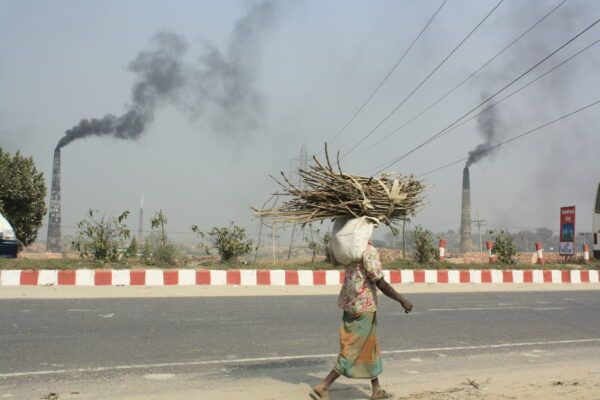This week, governments, funders, businesses and civil society gathered at London Climate Action Week to consider a tough question: how do we make meaningful and fair climate progress amid mounting geopolitical and economic headwinds?
Decarbonisation is essential to addressing climate change long term, but the current moment demands smarter action now. We need to see more complementary strategies that deliver faster benefits for the people and ecosystems most at risk. Cutting super pollutants, like tropospheric ozone, is an overlooked opportunity hiding in plain sight.
Tropospheric ozone is a potent but under-addressed greenhouse gas and super pollutant that threatens climate stability, public health, and food and ecosystem security. We previously made the case for action on tropospheric ozone based on the promise of fast, cross-cutting environmental and health gains. Our new report, Accelerating Action on Tropospheric Ozone: A Strategic Roadmap for 2025-2030, lays out a practical roadmap for how to tackle the pollutant utilising the policies, platforms and frameworks already in place.
To limit global warming to 1.5°C, as outlined in the Paris Agreement, greenhouse gas emissions must be reduced by 45% from 2010 levels by 2030 and reach net zero by 2050. If taken to its full potential, reductions of tropospheric ozone precursors, alongside reductions of methane, could result in 0.30°C of avoided warming by 2050.1
A triple threat hiding in plain sight
Ozone exists in two layers of the atmosphere: the troposphere and the stratosphere. Tropospheric ozone is ‘bad ozone’ closer towards earth’s surface, which is different from the ‘good ozone’ layer in the stratosphere, which protects us from harmful radiation.
Tropospheric ozone forms when pollutants like methane, nitrogen oxides (NOx), carbon monoxide (CO), and volatile organic compounds (VOCs) interact in the presence of sunlight. Ozone is not emitted directly and doesn’t behave like other pollutants – its formation depends on complex chemistry, meteorology and geography. Tropospheric ozone and its precursors can move across borders and regions making it hard to track, model and regulate. But its impacts are clear:
- 0.23°C of global warming to date, making tropospheric ozone the third most powerful greenhouse gas after CO2 and methane.
- 500,000+ premature deaths annually, with links to asthma, cardiovascular disease and other chronic health conditions.
- Up to 26% losses in staple crop yields, like wheat, rice, and maize.
- 11% drop in forest productivity, weakening the planet’s key carbon sinks.
Yet action on ozone is largely fragmented, as current approaches to managing tropospheric ozone tend to focus on one part of this complex problem. We need an approach that cuts across multiple levels of government and sectors. As global temperatures rise and methane emissions surge, ozone levels are increasing in all business-as-usual scenarios.
Fragmented action = missed opportunities
Today’s efforts to manage ozone are disjointed and narrow. Air pollution policies focus on short-term exposure, often implemented at the city or regional level. Climate policies target methane, but not ozone formation directly. Agricultural and ecosystem impacts are entirely unconsidered. There is currently no single mechanism that connects these approaches under a unified objective to reduce the total tropospheric ozone burden.
This lack of coordination means we are missing a major opportunity for people and planet. Tropospheric ozone cuts across nearly every sector and level of government, but is owned by none. Without an integrated approach, ozone levels will keep rising, undermining efforts to meet climate, health, and food and ecosystem security goals.
Our roadmap offers a new path forward built on three key principles:
- Multi-pollutant strategies: These consider tackling multiple pollutants together – rather than one by one – to avoid unintended consequences, maximise co-benefits and ensure ozone reduction efforts are effective given its complex chemistry.
- Multi-level governance: Coordinated action across global to local institutions ensures ozone is addressed consistently within climate, air quality and health policies, avoiding disjointed or conflicting responses.
- Cross-sectoral collaboration: Addressing ozone requires solutions across diverse sectors – from transport to wildfires – and requires aligning existing policies and integrating ozone where it’s been overlooked.
Roadmap to results: Maximising existing efforts
This is a decisive decade for action on super pollutants. Rather than launching new institutions or frameworks, the roadmap urges us to integrate ozone into existing systems leveraging current climate agreements, clean air plans and the Sustainable Development Goals. We don’t need to reinvent institutions – we need to better align the ones we already have.
The roadmap outlines four core pillars to drive action:
- Science into policy: Close critical data gaps and improve modelling to support evidence-based decisions.
- Integrated governance: Embed ozone targets into air quality, climate and agricultural policies at all levels.
- Accelerated measures: Scale up practical, multi-sectoral solutions within and outside of existing decarbonisation efforts.
- Public awareness: Raise the political and public understanding of ozone as a strategic target for near-term gains.
Rising temperatures, shifting weather patterns and surging methane levels are already setting the stage for higher ozone concentrations. This roadmap makes clear that the tools already exist. What’s needed now is the political will, cross-sectoral cooperation and global coordination to connect the dots.
1 Methane reductions and methane-mediated ozone reductions are projected to result in 0.19 degrees of avoided warming. Reductions of non-methane ozone precursors (NMVOCs, CO, NOx) are projected to result in 0.11 degrees of avoided warming by 2050. Taken together, these pathways could result in 0.30 degrees of avoided warming.


